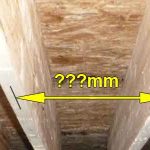Noggins are small pieces of timber that sit between larger timbers, such as wall studs, and floor joists. They offer several advantages. The main ones are:
- They tie the surface together, providing a stronger, more rigid frame.
- Noggins will stop individual joists or studs from twisting, warping or any other movement.
- They will provide a better fixing for plasterboards, where each edge is hitting a timber.

In most cases, it is recommended to use noggins in between your ceiling joists. However, they are not always a strict requirement. Your decision could be based on several factors, including:
- Thickness of the plasterboards being used
- Joist spacing.
- The overall joist size and span
Ceiling noggins for fitting plasterboards
When fitting plasterboards, the shorter edge will usually run parallel with the joists. A standard plasterboard is 1200mm x 2400mm. This means, on a ceiling with joists spaced at 400mm, there will be 7 rows of screws in a board. For 600mm centres there will be 5 rows.
On the long side of the board, you will have fixings in the joists. These will be at either 400 or 600mm, in relation to the joist spacing. In between these joists, at the edge of the board, there will be a gap where the board is not sat on anything.
This is potentially an area where the plasterboard could move and flex. When boards are able to move, this can cause the plaster to crack.
If you are using 9.5mm plasterboards, you should add rows of noggins every 1200mm. This will ensure that every edge of your board lands on a timber, and this will avoid any weak joints.
9.5mm is the thinnest plasterboard you would use on a ceiling. There is a lot of flex in these boards. Therefore you would never use this on a ceiling with 600mm centres. But even with 400mm centres, noggins would be highly recommended (essential in my opinion).
If you wanted to avoid installing noggins, a minimum plasterboard thickness of 12.5mm would be required at 400mm centres.
For a ceiling with joists spaced at 600mm centres, you shouldn’t really be using 9.5mm boards at all. These are far too thin and even with noggins, there is a far greater risk of the board sagging.
At this spacing, if you were using a 12.5mm board, you would need noggins every 1200mm. This would ensure all joints are landing on a solid piece of timber.
If you wanted to avoid noggins, you would need to use 15mm plasterboards. This would reduce the flex at this spacing.
Noggins in engineered joists
It is worth noting, that even with thicker boards, there still can be movement. Especially in standard timber joists that are prone to warping and twisting. As well as expansion and contraction, with moisture and temperature changes.
This is less of an issue if you are using engineered joists. For example, I Joists and posi joists.
Both of these are manufactured and therefore they don’t suffer from the movement found in natural timber.
Engineered joist manufacturers will often recommend 600mm centres and no need for noggins.
However, whilst there isn’t the same risk of movement in the timber, the plasterboard flex at 600mm centres is still a serious consideration. You should still avoid 9.5mm boards at this spacing. Also, 12.5mm plasterboard would still be at a risk without noggins.
Therefore, I would still recommend 15mm boards, especially if you aren’t adding additional noggins.
Using ceiling noggins to add support
As well as being useful for fitting plasterboards, noggins also add a great deal of strength and support to the ceiling/floor.
Natural timber is quite prone to movement, and its never 100% straight. Adding noggins between timber joists, is a great way to level the surface out.
When you fit a full row of noggins, this will pull each joist in line with the next one. It will naturally pull out any bellies and twists in the timber. This means, all the joists should line through nice and straight.
Firstly, this will give a great finish to your ceiling below and secondly it will minimise any future movement in the joists.
If your noggins are fitted end to end, with straight cuts, it will be very hard for individual timbers to move and twist. This means, your ceiling should remain nice and flat over time. It will also reduce the chance of plaster cracking due to movement.
Perimeter noggins
As we have already mentioned, ideally, every edge of your board should be supported. This means it should be sitting on the length of a joist, or along a row of noggins.
For standard plasterboards at 1200mm x 2400mm, this would require a row of noggins every 1200mm.
However, you should also ensure you don’t forget the edges of the room. This is the area right next to the walls. Just like gaps between joists on the edge of a board at 1200mm, there will also be gaps at the wall.
Therefore, you should make sure you add sufficient noggins to the perimeter of the room. This will support the edges of boards where they meet the wall.
Conclusion
Whether a ceiling requires noggins or not, can vary based on several factors. The main things you consider, will be the space between joists and also the plasterboard thickness you are using.
When you have smaller spaces between joists and thicker plasterboards, there is an argument that noggins are not 100% required.
With that said, adding noggins will only make your joists stronger. If this is your own home and you have spare timber, then the small amount of extra work would be well worth it in my opinion.
If you do decide that you won’t be installing noggins, the main consideration will be using a plasterboard that is sufficiently strong, to compensate for any gaps it will span on its edge




